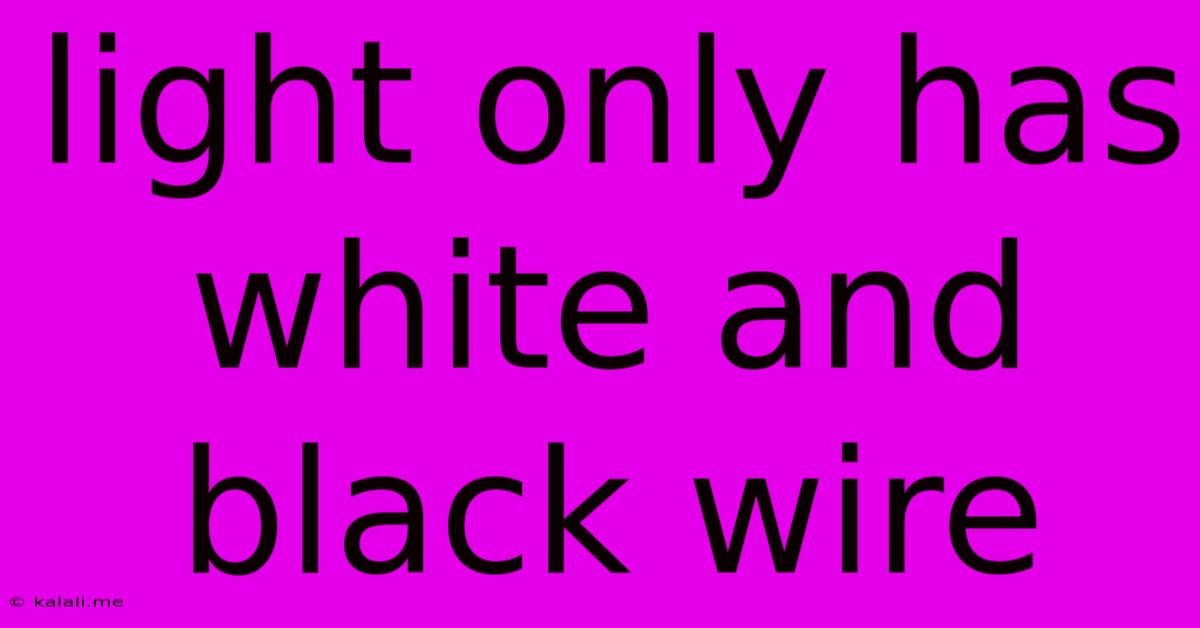Light Only Has White And Black Wire
Kalali
May 30, 2025 · 3 min read

Table of Contents
The Myth of White and Black Wires Only in Lighting Circuits: A Comprehensive Guide
Many homeowners and even some electricians harbor a misconception: that lighting circuits only use black and white wires. This is incorrect and can lead to dangerous situations. This article will dispel this myth and explain the various wiring configurations you might encounter in lighting circuits. Understanding this is crucial for safe and compliant electrical work. Always prioritize safety and consult a qualified electrician for any electrical work you are unsure about.
Understanding Basic Wiring Colors:
While black and white wires are common in lighting circuits, they don't tell the whole story. Here's a breakdown of the standard wire colors and their functions:
- Black (Hot): Carries the electrical current from the power source.
- White (Neutral): Returns the current to the power source, completing the circuit.
- Green or Bare Copper (Ground): Provides a path for fault currents to safely reach the ground, preventing electric shock. This is a crucial safety feature.
- Red, Blue, or Yellow (Hot): These colors are often used in multi-wire branch circuits (MWBCs), carrying additional hot wires for increased capacity.
Why You Might See Other Wires in Lighting Circuits:
Several scenarios explain why you might find more than just black and white wires in your lighting fixtures:
- Switched Outlets: Lighting circuits often incorporate switched outlets, requiring additional wires to control the power to the outlet independently of the light fixture. This commonly involves a switch leg (often red or blue) carrying power to the outlet.
- Multi-Way Switching: Controlling a light from multiple locations (e.g., a hallway light with switches at both ends) involves traveler wires (often red and black) that carry the signal between switches.
- Three-Way or Four-Way Switches: These advanced switching mechanisms require multiple wires to control the lighting from multiple points. This often incorporates a combination of traveler wires and switch legs.
- Dimmers: Dimmers often require more complex wiring, sometimes involving additional wires to control the dimming function.
- Smart Lighting Systems: Integrated smart lighting systems frequently use more wires to facilitate communication and control capabilities beyond simple on/off functionality.
Why the Misconception Exists:
The misconception likely stems from the simplicity of basic lighting circuits. In many basic installations, only black (hot), white (neutral), and ground wires are visible, leading to the erroneous assumption that this is the only configuration.
Safety Precautions:
Always treat all electrical wiring with caution. Before working on any electrical circuit, always:
- Turn off the power: Use a circuit breaker or fuse box to completely disconnect the power to the circuit.
- Double-check: Ensure the power is off using a non-contact voltage tester.
- Use appropriate tools: Employ proper tools and techniques for working with electrical wiring.
- Consult a professional: If you are unsure about any aspect of electrical wiring, consult a qualified electrician.
Conclusion:
While many basic lighting circuits may only use black and white wires alongside a ground wire, assuming this is always the case is dangerous. Understanding the different wiring configurations and the purpose of each wire is essential for safe and compliant electrical work. Prioritizing safety and seeking professional help when needed is paramount. Remember, proper electrical work protects your home and family.
Latest Posts
Latest Posts
-
How To Find A Vector Perpendicular
May 31, 2025
-
How To Normalize Data Between 0 And 1
May 31, 2025
-
How Long Does Gas Stay Good In A Gas Can
May 31, 2025
-
How To Remove A Silicone Sealant
May 31, 2025
-
Bathroom Exhaust Fan Not Pulling Air
May 31, 2025
Related Post
Thank you for visiting our website which covers about Light Only Has White And Black Wire . We hope the information provided has been useful to you. Feel free to contact us if you have any questions or need further assistance. See you next time and don't miss to bookmark.